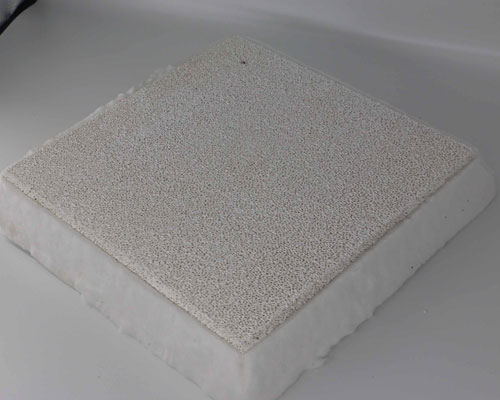If a foam filter is required that has characteristics ranging from coarse to fine throughout its thickness, it is possible to combine two or more types of polyurethane foam panels with appropriately different pore sizes. Naturally, the ceramic foam can have any desired configuration based on the configuration required for a particular molten metal filtration process. Although these configurations can naturally be varied, a specific configuration may be preferable for filtering in the conveying tank between the furnace and the mold when the molten aluminum is filtered. The advantages of ceramic foam materials are that the ceramic foam has sufficient strength properties to resist the erosion of molten metal, and does not require excessive molten metal head to start the filtration process.
The molten metal filtration method by a ceramic foam filter is characterized in that the molten metal is poured into the ceramic material at a rate of 5.0 to 50 cubic inches per square inch of filtering area per minute. For aluminum, the filtration area per minute is preferably 10 to 30 cubic inches per square inch. The minimum metal flow rate in a normal aluminum casting operation is about 200 pounds. No more than 2000 pounds per minute. The metal flow rate per minute, a typical bulk metal flow rate is about 500 pounds. Ceramic materials are very suitable for successful operation with bulk metal flow rates. Generally, for aluminum, the specific flow rate of the metal in the filter should not exceed 5 pounds. The metal filling amount per square inch of the filter cross section per minute should preferably be less than 3 pounds. Every square inch per minute.
The flow rate through the filter is higher than the above indicated value, which will cause the filter to pass too many undesirable non-metallic substances, and thus cannot produce high-quality sheet products. The lower limit is determined by actual size considerations, and an unrealistically large filter will be required to handle bulk metal flow exceeding 1,000 pounds. Every minute, a ceramic filter larger than 45 square inches or 2025 square inches is required. Therefore, a typical filter of the present invention can be defined as a 16 inch square or about 250 square inches designed to pass 500 pounds. Metal flow rate at a specific flow rate of 2 pounds per minute.
The quality of the input metal is an important variable. If the input metal is particularly dirty, and if the preferred relatively fine foam is used, it will quickly clog the ceramic filter of the present invention. The output quality, that is, the resulting filtered metal is a function of the input quality. Therefore, the lowest input quality should be provided to ensure good output quality.
In order to ensure good output quality, the molten metal can be pre-filtered through a coarse ceramic foam filter, and a series of foam filters with reduced porosity can be optimally used. Alternatively, a single preliminary filter or a single filter may be used, which has a gradient that can pass through its thickness from coarse (high permeability) to fine (low permeability).

